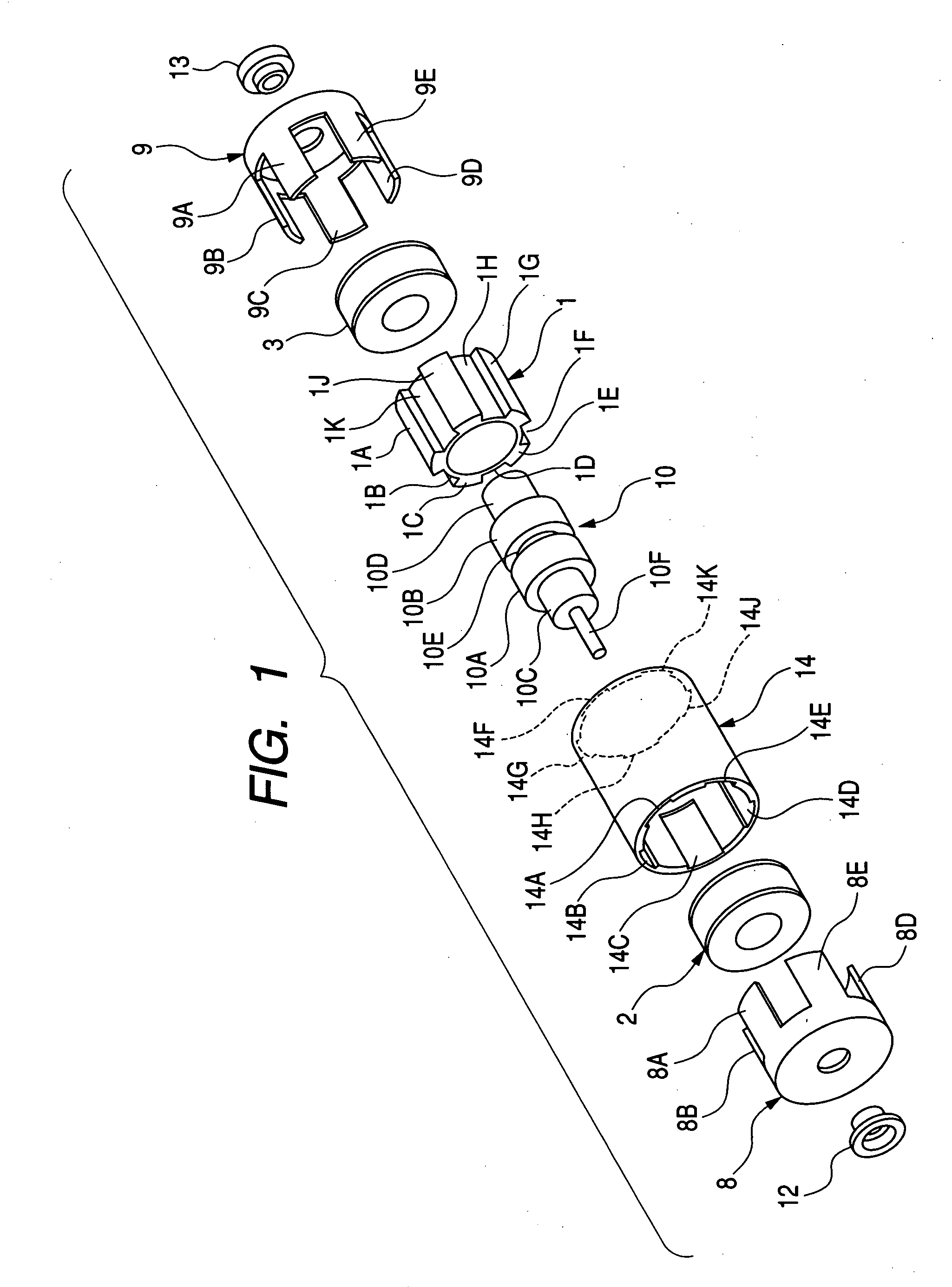Stepping motor
a technology of stepping motors and stepping plates, applied in the field of stepping motors, can solve the problems of increasing manufacturing costs, inability to rotate, and difficulty in integral structure of parts from the perspective of parts manufacturing, and achieve the effect of high output and high resolution
- Summary
- Abstract
- Description
- Claims
- Application Information
AI Technical Summary
Benefits of technology
Problems solved by technology
Method used
Image
Examples
embodiment 1
[0034] FIGS. 1 to 4A through 4H are diagrams related to Embodiment 1 of the present invention. Of the drawings, FIG. 1 is an exploded perspective view of a stepping motor, and FIG. 2 is an axial sectional view of the stepping motor of FIG. 1 in the assembled state. FIG. 3A is a sectional view taken along the line 3A-3A of FIG. 2, and FIG. 3B is a sectional view taken along the line 3B-3B of FIG. 2.
[0035] In the drawings, reference numeral 1 indicates a cylindrical magnet ring constituting a rotor. Its outer peripheral surface is circumferentially divided into n portions at equal intervals (n is an even number, which, in this embodiment, is 10). The divided portions are formed as radial protrusions and recesses (The protrusions are indicated by symbols 1A, 1C, 1E, 1G, and 1J, and the recesses are indicated by symbols 1B, 1D, 1F, 1H, and 1K), and are radially magnetized. In Embodiment 1, the inner peripheral surface is magnetized into an S-pole, and the outer peripheral surface, that...
embodiment 2
[0061]FIG. 5 is a sectional view of a stepping motor according to Embodiment 2 of the present invention. The components that are the same as those of Embodiment 1 are indicated by the same symbols, and a description thereof will be omitted.
[0062] In FIG. 5, reference numeral 15 indicates a first bobbin, around which the first coil 2 is wound. The first bobbin 15 is formed of a non-magnetic and non-conductive material, preventing inadvertent conduction between the first coil 2 and the first stator 8. The first bobbin 15 is fixed to the first stator 8, and the output shaft 10 is rotatably held by a hole 15A, providing the same function as the first bearing 12 of Embodiment 1. Reference numeral 16 indicates a second bobbin, around which the second coil 3 is wound. The second bobbin 16 is also formed of a non-magnetic and non-conductive material, preventing inadvertent conduction between the second coil 3 and the second stator 9. The second bobbin 16 is fixed to the second stator 9, an...
embodiment 3
[0064]FIG. 6 is a perspective view of the construction of a sheet-like magnet (permanent magnet) according to Embodiment 3 of the present invention. FIGS. 7A and 7B are sectional views of the output shaft of a stepping motor according to Embodiment 3 of the present invention, and a sheet-like magnet wound around the output shaft. More specifically, FIG. 7A is a sectional view of a portion near the first inner magnetic pole portion taken along a direction perpendicular to the axis, corresponding to FIG. 3A of Embodiment 1, and FIG. 7B is a sectional view of a portion near the second inner magnetic pole portion taken along a direction perpendicular to the axis, corresponding to FIG. 3B of Embodiment 1. The components that are the same as those of FIGS. 1 to 4A through 4H are indicated by the same symbols, and a detailed description thereof will be omitted.
[0065] In these drawings, reference numeral 20 indicates a sheet-like magnet formed of a flexible material, such as rubber, having...
PUM
 Login to View More
Login to View More Abstract
Description
Claims
Application Information
 Login to View More
Login to View More - R&D
- Intellectual Property
- Life Sciences
- Materials
- Tech Scout
- Unparalleled Data Quality
- Higher Quality Content
- 60% Fewer Hallucinations
Browse by: Latest US Patents, China's latest patents, Technical Efficacy Thesaurus, Application Domain, Technology Topic, Popular Technical Reports.
© 2025 PatSnap. All rights reserved.Legal|Privacy policy|Modern Slavery Act Transparency Statement|Sitemap|About US| Contact US: help@patsnap.com



